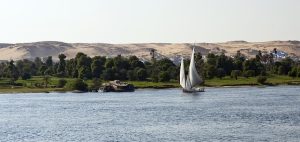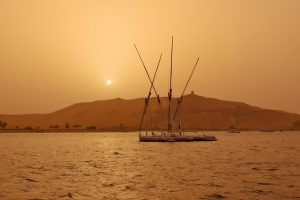
The Nile River is the longest river in the world, stretching almost 6,700 km! It’s located in northeast Africa and consists of two main tributaries – Blue Nile and White Nile. The second has been of crucial meaning for the countries it’s flowing through. Sudan and South Sudan rely on its waters to transform the sand into lush and use it as a main transport corridor. The impact of the White Nile on local economies and biodiversity is huge! Governments work directly with various organizations and movements to face together the upcoming challenges posed by climate change and the overuse of river resources.
Headwaters and Course

The White Nile River has two meanings, and In the wider sense, it’s collective for all stretches from Lake Victoria to the Blue Nile merger. However, if we have to be more strict, this is the river formed in South Sudan’s Lake No. The sediment carried by the water comes partially from the Bahr al Jabal and Bahr el Ghazal Rivers merging at the lake. It makes the White Nile waters pale, almost white. Besides Sudan and South Sudan, the river flows through Uganda, Tanzania, Rwanda, Ethiopia, and the Democratic Republic of the Congo if we consider it in a wide sense.
It includes the headwaters of Lake Victoria at some points. It’s accepted that Ruvyironza and Nyabarongo, emerging in Burundi and Rwanda, are the main tributaries of the lake. These rivers meet at the Rwanda and Tanzania border near Rusumo Falls. In Uganda, White Nile is known as Victoria Nile and Albert Nile. The first stretches from Lake Victoria’s outlet to Lake Albert, and from that point, it continues to the border of South Sudan. From that moment, the river is known as Mountain Nile, and from Lake No, it becomes White Nile officially until it confluences with Blue Nile in Sudan.
The total length of the White Nile is about 3,700 km, and it’s an important waterway between Lake Albert and Khartoum. East from Lake No, it flows about 120 km to Sobat, where it holds numerous lagoons and swamps. The smaller river contributes greatly to white sediment when in flood. In all its meanings, the White Nile River impacts the environment and is the main reason for changing the desert lands into more life-friendly surroundings.
To compare it to our local rivers in Pennsylvania, we are blessed with a network of picturesque rivers that crisscross its diverse landscape. The state’s major rivers, such as the mighty Susquehanna, the scenic Delaware, and the historic Allegheny and Monongahela rivers, have played a pivotal role in shaping its history and culture. These waterways not only provide vital resources for transportation, industry, and agriculture but also offer opportunities for outdoor enthusiasts to enjoy activities like kayaking, fishing, and scenic river cruises. Pennsylvania’s economic landscape not only helps its own environment- it extends to the White Nile. Because of the best online casinos in Pennsylvania and their support of our cause, we are able to spread awareness to everyone in the United States and our local communities in the PA.
Life in the River

There is a good reason for the Nile to be considered the River of Life and various habitats change in the territories of two main stretches. In contrast to the tropical rainforests prevailing in part flowing through the Democratic Republic of the Congo, White Nile provides lower vegetation, especially in its part in Sudan. Open grassland, thorny trees, and thin bush are much more likely in the swamp territories. Papyrus is the most widespread plant, together with bamboo-like grasses, water lettuce, and water hyacinth. Thornbush and small tree stands are scattered to the north.
The White Nile River ecosystem is home to a variety of fish. One of the most impressive species in size is the Nile perch, which can grow to more than 80 kg. Other common fish in the river are barbel, catfish, mudfish, lungfish, water leopard, eel, elephant-snout fish, and many others. Plenty of reptiles, insects, and birds have also made the White Nile their home. The common ostrich is the biggest feathered specie, living mainly in the Sudan part of the river.
White Nile is one of the most amazing places around the world when it comes to animals. It’s a unique habitat for many huge titans, like the Nile Crocodile – the second largest reptile living nowadays. Here are more of the magnificent brutes of the river:
- Hippopotamus – it’s one of the African symbols and the third biggest mammal on Earth. Hippopotamus reproduce and live longer parts of their lives in the water, aggressively guarding their territories.
- Nile Crocodile – one of the biggest reptiles on the planet, is also unique to these waters. It has a length ranging from about 3 to more than 5 meters and has an exclusive carnivore diet. Crocodiles are apex predators in the Nile and are feared for their silent movement and very aggressive behavior.
- Monitor Lizard – it’s part of the Varanidae family and has very strong jaws and muscular bodies. They can grow to above 200 cm in length and feed on anything they can reach – fish, birds, smaller mammals, and even Crocodile eggs.
- Soft-Shelled Turtle – although they can’t exactly be called brutes, these turtles are typical for the river and have an omnivorous food menu. They feed on seeds, nuts, and fruits, but also small mammals, crustaceans, fish, and amphibians.
- Snakes – White Nile is home to several types of cobras, mambas, including Black Mamba, water snakes, egg-eating snakes, and many others.
Local Economy Impact

Hardly anyone doubts that a huge river like the Nile has a huge impact on the economies of the countries it flows through. Unquestionably, irrigation takes the first place, especially in regions with water and rain deficits. Here are the main uses of the river resources as per their influence and importance for the local residents:
- Irrigation – waters and sediments are of crucial importance for agriculture in the region. The most common crops and products are oranges, potatoes, rice, wheat, corn, and cotton.
- Navigation and Trade – White Nile is a key transportation and trade route connecting African countries with each other and the rest of the world. Navigation is possible in large parts of the river, and several canals have been built over the years.
- Water Reservoirs – the river itself is a massive reservoir, but nations have built several huge dams for local usage. In 1937 was completed the Jebel Aulia Dam in Sudan, which was the largest in the world at that time.
- Fishing – this part of the economy is important in micro and macro scale. Many people in Sudan and the other river countries live within a mile and support their livelihoods with the available resources. Moreover, fishing is an important economic sector for South Sudan, Rwanda, and Ethiopia.
”Save the White Nile”
” Save the White Nile” is a non-political movement established in Uganda by a group of individuals aiming at protecting the local economy and the unique river biodiversity. The organization was created to oppose the Isimba Hydropower project. The massive dam was completed in 2019, after all, and added 183 MW of electricity to Ugandan’s grid. However, the movement continues to be active in an attempt to protect local tourism, expressed in the use of the river for rafting and other similar activities.
” Save the White Nile” represents the people who may lose from an eventual illegal Kalagala Offset Indemnity Area flooding. The group strives to raise awareness and help people oppose future plans of the World Bank and the Government of Uganda. It all started with the completion of the Bujagali Hydroelectric Project in 2011. During the construction, in 2007 was signed the Kalagala Offset Indemnity Agreement (KOIA) from the above-mentioned parties and the International Development Agency. It had to prevent further development of the region and the construction of other huge dams that can include the river stretches in their reservoirs.
Despite KOIA, the World Bank did nothing against the loan from the Export-Import Bank of China accepted by the Government of Uganda. It was for the planning and construction of three dams within the Isimba Hydro Power Station project. Even if the initiative was lost, the movement is very important for the local communities as it serves as a consolidator of the voices of those who can’t be heard!
